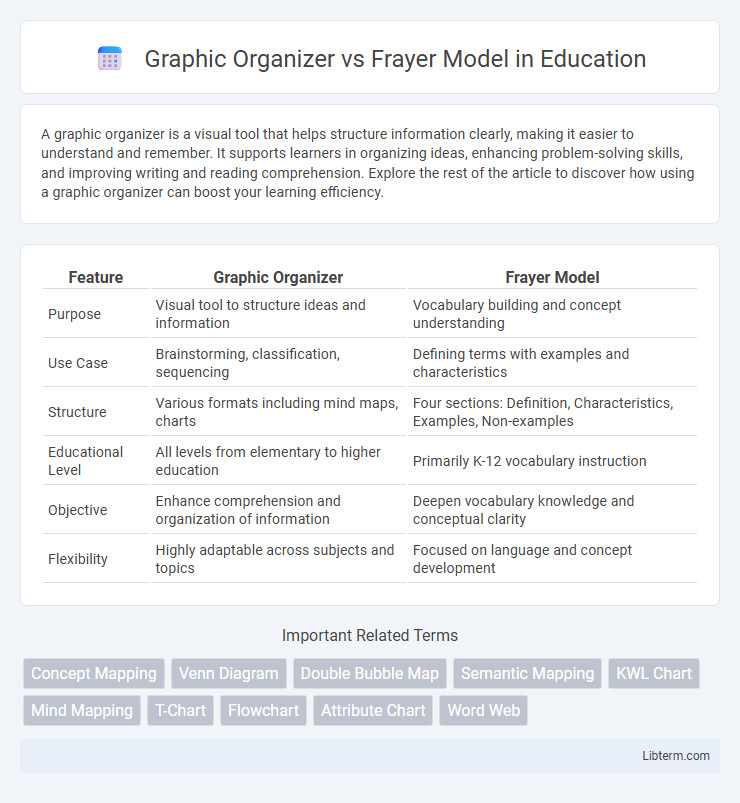A graphic organizer is a visual tool that helps structure information clearly, making it easier to understand and remember. It supports learners in organizing ideas, enhancing problem-solving skills, and improving writing and reading comprehension. Explore the rest of the article to discover how using a graphic organizer can boost your learning efficiency.
Table of Comparison
| Feature | Graphic Organizer | Frayer Model |
|---|---|---|
| Purpose | Visual tool to structure ideas and information | Vocabulary building and concept understanding |
| Use Case | Brainstorming, classification, sequencing | Defining terms with examples and characteristics |
| Structure | Various formats including mind maps, charts | Four sections: Definition, Characteristics, Examples, Non-examples |
| Educational Level | All levels from elementary to higher education | Primarily K-12 vocabulary instruction |
| Objective | Enhance comprehension and organization of information | Deepen vocabulary knowledge and conceptual clarity |
| Flexibility | Highly adaptable across subjects and topics | Focused on language and concept development |
Introduction to Graphic Organizers and the Frayer Model
Graphic organizers visually structure information to enhance comprehension and learning by categorizing concepts, relationships, and ideas. The Frayer Model is a specific type of graphic organizer that focuses on vocabulary development by defining a term, describing its characteristics, providing examples, and noting non-examples. Both tools promote critical thinking and retention but differ in their targeted applications and design.
Defining Graphic Organizers
Graphic organizers are visual tools that help structure information, making complex concepts easier to understand and remember by organizing data into categories or steps. The Frayer Model, a specific type of graphic organizer, focuses on defining a concept by exploring its definition, characteristics, examples, and non-examples. Compared to general graphic organizers, the Frayer Model provides a targeted approach for vocabulary development and deeper comprehension of key terms.
Understanding the Frayer Model
The Frayer Model is a graphic organizer designed to enhance vocabulary comprehension by dividing information into four distinct sections: definition, characteristics, examples, and non-examples. This structured approach helps learners deepen their understanding of complex concepts by analyzing their meaning in a multifaceted way. Unlike general graphic organizers, the Frayer Model specifically targets conceptual clarity and critical thinking through contextual analysis.
Key Differences Between Graphic Organizers and the Frayer Model
Graphic organizers are versatile visual tools that structure information through diagrams like mind maps or flowcharts, clarifying relationships between concepts and ideas. The Frayer Model specifically focuses on vocabulary development, using a four-square chart to define a term, list its characteristics, provide examples, and note non-examples. While graphic organizers serve broad purposes in organizing diverse information types, the Frayer Model excels as a targeted strategy for deepening understanding of specific concepts or terms.
Advantages of Using Graphic Organizers
Graphic organizers enhance learning by visually structuring information, which improves comprehension and retention of complex concepts. They cater to diverse learning styles, enabling students to organize ideas, identify relationships, and synthesize data effectively. Compared to the Frayer Model, graphic organizers offer greater versatility across subjects and can be customized to support brainstorming, sequencing, and problem-solving activities.
Benefits of the Frayer Model in Learning
The Frayer Model enhances vocabulary acquisition by encouraging deep understanding through definitions, characteristics, examples, and non-examples, which promotes critical thinking and retention. Its structured format supports learners in connecting new concepts to prior knowledge, resulting in improved comprehension and long-term memory. Unlike general graphic organizers, the Frayer Model specifically targets word meaning, making it highly effective for language development and subject-specific terminology.
Common Use Cases in the Classroom
Graphic organizers are widely used in classrooms to visually map out information, aiding students in organizing ideas during reading comprehension, brainstorming, and project planning. The Frayer Model specifically supports vocabulary development by helping students define terms, identify characteristics, and provide examples and non-examples, enhancing conceptual understanding. Both tools improve critical thinking and retention, with graphic organizers excelling in structuring diverse content and the Frayer Model targeting deeper word analysis.
When to Choose a Graphic Organizer vs. the Frayer Model
Choose a graphic organizer when visualizing relationships between multiple concepts or organizing complex information like compare and contrast charts, flowcharts, or cause-and-effect diagrams. Opt for the Frayer Model specifically when defining vocabulary or key terms, as it breaks down meaning, characteristics, examples, and non-examples to deepen understanding. In contexts requiring detailed concept analysis, the Frayer Model excels, while graphic organizers are better for structuring broader or interconnected ideas.
Tips for Effective Implementation
Maximize the effectiveness of graphic organizers by selecting designs that align with learning objectives and student needs, ensuring clarity and simplicity in layout. When using the Frayer Model, emphasize key vocabulary by incorporating clear definitions, characteristics, examples, and non-examples to deepen conceptual understanding. Consistent practice, coupled with guided instruction and opportunities for student collaboration, enhances engagement and retention for both tools.
Conclusion: Selecting the Right Tool for Learning
Choosing between a graphic organizer and the Frayer Model depends on the learning objective and content complexity; graphic organizers excel in visualizing relationships and structuring information, while the Frayer Model is highly effective for defining and understanding key vocabulary concepts. Educators should consider the cognitive demands of their lessons, with graphic organizers supporting holistic comprehension and the Frayer Model reinforcing critical thinking through word analysis. Integrating both tools strategically enhances student engagement and deepens knowledge retention across diverse subjects.
Graphic Organizer Infographic

 libterm.com
libterm.com